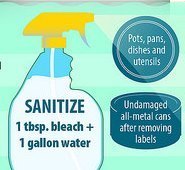Food Safety and Kitchen Cleaning After a Disaster
 Flooding can cause power outages for hours, days and even weeks, which may make food unsafe to eat. Flooding can cause power outages for hours, days and even weeks, which may make food unsafe to eat.
If a fire, flood, power outage or natural disaster impacts your home, minimize the potential loss of food and reduce the risk of foodborne illness by knowing how to determine food safety.
You can learn the right decisions for keeping your family safe after a power outage with food and cleaning safety facts from the United States Department of Agriculture (USDA).
After a Flood
· Use bottled drinking water that has not come into contact with flood water.
· Do not eat any food that may have come in contact with flood water.
· Discard any food that is not in a waterproof container if there is any chance it may have come in contact with flood water. Food containers that are not waterproof include those with screw-caps, snap lids, pull tops, and crimped caps.
· Discard cardboard juice/milk/baby formula boxes and home canned foods if they have come in contact with flood waters. They cannot be cleaned and sanitized effectively.
· Inspect canned foods; discard any food in damaged cans. Check cans for swelling, leakage, punctures, holes, fractures, extensive deep rusting, or crushing/denting severe enough to prevent normal stacking or opening with a manual, wheel-type can opener.
· Discard wooden cutting boards, plastic utensils, baby bottle nipples, and pacifiers that may have come in contact with flood waters. There is no way to clean them safely.
· Thoroughly wash metal pans, ceramic dishes, utensils (including can openers) with soap and water (hot water if available). Rinse and sanitize them by boiling in clean water or immersing them for 15 minutes in a solution of 1 tablespoon of unscented, liquid chlorine bleach per gallon of drinking water.
· Thoroughly wash countertops with soap and water (hot water if available). Rinse and then sanitize them by applying a solution of 1 tablespoon of unscented, liquid chlorine bleach per gallon of drinking water. Allow it to air-dry.
· Note: If your entire refrigerator or freezer was in flood waters — even partially — it is unsafe to use and must be discarded.
After a Weather Emergency
The USDA also issued a news release with food safety tips to follow in advance of losing power, steps to follow if the power goes out, and food safety after a flood. There were also steps to follow after a weather emergency.
· Check the temperature inside of your refrigerator and freezer. Discard any perishable food (such as meat, poultry, seafood, eggs or leftovers) that has been above 40°F for two hours or more.
· Check frozen food for ice crystals. The food in your freezer that partially or completely thawed may be safely refrozen if it still contains ice crystals or is 40°F or below.
· Never taste food to decide if it is safe.
· When in doubt, throw it out.
|












































